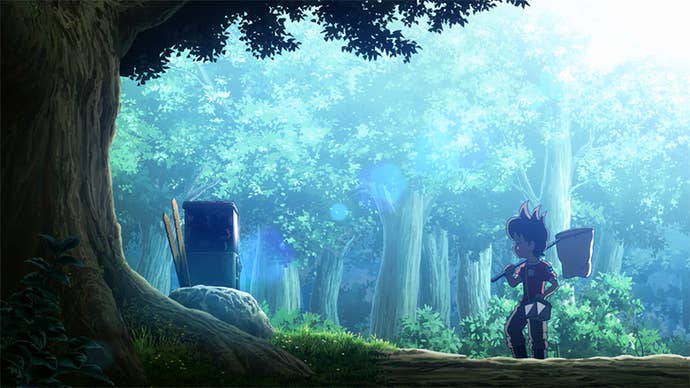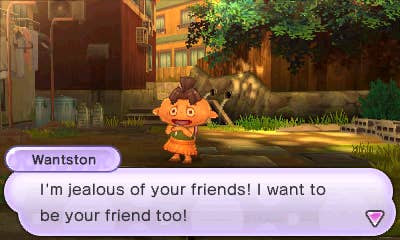Yo-Kai Watch 3DS Review: Borrowed Time
Level-5's monster-collecting RPG might not be wholly original, but it's perfect for lapsed Pokemon fans looking for a fresh take on a reliable formula.
This article first appeared on USgamer, a partner publication of VG247. Some content, such as this article, has been migrated to VG247 for posterity after USgamer's closure - but it has not been edited or further vetted by the VG247 team.
As someone who loved the original Pokemon games, I consider it a personal failing that I've barely been able to maintain enthusiasm for Nintendo's monster-collecting RPG since the close of the 20th century.
But maybe it's not completely my fault. Every time I start up a new Pokemon sequel, the fun runs out just as I realize I'm going through the motions all over again. But, regardless of what I think, this sense of tradition is the key to Pokemon's colossal success: Every game remains simple enough to ostensibly serve as someone's first RPG, while the series' pervasive sense of familiarity encourages returning players to dismiss the big picture and instead focus on the minor additions. Strip away the many coats of paint added by developer Game Freak over the past two decades, and, at its heart, Pokemon is still a simple, 8-bit RPG—one that nonetheless supports varying degrees of obsession.

With this desire to love Pokemon buried deep within my soul, it shouldn't be surprising to hear I took to Yo-Kai Watch so quickly; it takes the same basic concept, and reworks it for a generation far removed from the fairly antiquated experiences Pokemon leans on. It may be a little too simple for some, but Yo-Kai Watch understands the importance of keeping your attention at every possible moment. And while it's not without its problems, developer Level-5's relentless efforts to keep players engaged brought me back to those days where, as a slightly ashamed 16 year old, my life was consumed by a world of marketable monsters depicted in four stunning shades of green.
Gotta Catch 'Em All
Like Pokemon, Yo-Kai Watch revolves around a world overloaded with strange and mysterious creatures, though they aren't as much of a fact of life in the seriously non-Japanese setting of Springdale—in fact, they're invisible unless you're one of the select few wearing the titular Yo-Kai Watch. Essentially, Yo-Kai exist as a way to explain problems in the world, as each mischievous spirit serves a particular negative function in society: one makes you forget things, another makes you gossip, yet another helps you procrastinate, and so on. In this sense, Yo-Kai Watch really feels like the world as depicted through a very child-like lens: All of those complex, adult problems can just be dismissed with "a spirit did it." (One of the earliest missions in the game involves dispatching a Yo-Kai who's making your parents argue.)
If you've played previous 3DS Level-5 RPGs like Fantasy Life, Yokai Watch should feel pretty familiar. Like its predecessor, it also takes an episodic approach, with plenty of MMO-style quests surrounding the main objective to keep you and your party busy. Along with the usual fetch quests and "kill [X] number of [Y]" missions, Yo-Kai Watch's world is littered with things to do and find. With the touch of a button, you can bring up a radar to see if any Yo-Kai are nearby, then expose them with a variant of the extremely popular "hidden object" genre.

Even with its fairly urban setting, Yokai Watch manages to make exploring a cityscape interesting, and tucks away plenty of hidden treasures, mini-dungeons, and mysteries for players to find throughout its dense environments, including—in what feels like a nod to Pokemon's Hidden Machines—some you can only access once you level up your watch. And the best part about all of this exploration is you essentially opt into fighting hostile Yo-Kai. Encounters are limited to specific areas—where they can still be avoided—and if you spot a Yo-Kai that, for whatever reason, you don't want to fight, it's easy to back out of a potential battle.
And it's these battles that are, perhaps, Yo-Kai Watch's biggest departure from Pokemon. Instead of a typical, turn-based affair, its enemy encounters act more like Final Fantasy XIII's, where players take on the role of an RPG party coach who directs a mostly autonomous team. At first, this system may seem a bit too simple, but it soon opens itself up to plenty of possibilities. The six Yo-Kai in your party, for instance, exist as pie pieces in a circle, and placing them adjacent to members of the same "tribe"—think "type" in Pokemon terms—can bring passive benefits during enemy encounters. Mostly, battles feel like a manageable form of plate-spinning: Keeping health full with items, and turning your Yo-Kai wheel to bring weak spirits out of the fight and healthy ones in.
While your Yo-Kai act on their own, that doesn't mean you'll just be sitting back and making sure they don't lose too much HP. If anything, Yo-Kai watch wants to keep you engaged during every second of battle, even if your party runs on cruise control. Once a Yo-Kai's soul meter charges to capacity, you can then use their signature "Soultimate" move, which typically unleashes damage and/or status effects against all of your opponents.

And since performing these moves involves playing a seconds-long micro-game on the touchscreen, you also sacrifice time you could be healing or performing other non-automated duties in battle. The only downside is you'll be playing the same micro-games a lot, and the limited amount available aren't necessarily assigned to certain Yo-Kai. The same Soultimate move that required you to trace various shapes on a previous turn, for instance, may have you spinning a wheel on another turn. Granted, it's fun to see a Yo-Kai's flashy, silly superpower pulled off effectively, but after playing Undertale, I was a little disappointed with how little Yo-Kai Watch plays with the idea of using micro-games during RPG battles.
While Yo-Kai do most of the fighting on their own, the battle system has a way of keeping you constantly moving between different duties. The "target" function allows you to direct your Yokai's attention to a particular enemy, and lets you shoot down treasure-filled spirit orbs that randomly float through battle scenes. And if your Yo-Kai come down with a status effect, you can rotate them out of battle and play another touch-based microgame to get them back on their feet—and earn a bit of extra experience for doing so. Even if the UI looks like it was designed by Playskool, there's a surprising amount of stuff packed into this battle system; the first few bosses actually handed my butt to me before I fully wrapped my mind around Yo-Kai Watch's version of RPG multitasking.
You Know, for Kids!
If you're looking for the surprising amount of depth Pokemon's gained over the years, Yo-Kai Watch may disappoint you a bit. The "tribe" system isn't nearly as essential as Pokemon types; since it's mostly used as a way to bring about passive benefits in battle, you won't necessarily be setting out to develop a well-rounded team. Most of the time I rolled with a Yo-Kai wheel featuring just two or three different tribes in order to have a few boosts to choose from during battle. And there's not a whole lot of customization, either: Your Yo-Kai can equip an accessory, but their moveset is prescribed, and, to be honest, assembling a party often boils down to choosing the monsters you like the most—or ones with Soultimate moves you find super effective. As expected, they can evolve, and you can combine Yo-Kai using a very Persona-like system, but if you plan your battles correctly, there's really no wrong way to assemble a party.
A lot of this simplicity can be chalked up to the fact that Yo-Kai Watch is made for the younger set, but that's not necessarily a bad thing. The low numbers, charming world, and constant micro-games throughout actually reminded me a lot of the Paper Mario series, another RPG brand with kiddie appeal that adults nonetheless love as an alternative to meatier games.

If you're a fully grown human, though, a bit of Yo-Kai Watch's child-friendly elements can come off as a bit patronizing. Where Pokemon imagined a vast fantasy world where kids can leave school behind to tour the world with a pack of privately owned monsters, Yo-Kai's source material is a little more pedestrian. You're just a kid blessed with a magical device, tasked with solving the problems of others by destroying the evil spirits behind them. As a fan of Majora's Mask, I can't say I'm opposed to games about helping people, but, at times, Yo-Kai Watch seems a little too goody-goody. Many of the game's missions feel like they're also trying to teach children important life lessons that aren't particularly relevant to someone born during the Reagan administration: Go to bed on time, do your homework, don't gossip about others, look both ways before crossing the street, etc. If this game had a Dungeons & Dragons alignment, it'd definitely be "annoyingly lawful good."
Despite these minor issues, though, Yo-Kai Watch impressed me by how thoroughly it managed to keep my attention during the review process. And that's likely because it was designed to keep children engaged in an age of smart devices—which explains the sheer amount of things to do and rewards to be had around every corner. Pokemaniacs might crucify me for saying this, but Yo-Kai Watch really feels like the reinvention its predecessor needed years ago. True, I never play Pokemon for the high-level stuff, but then again, I'm guessing most people don't, either. And if Pokemon spoke to you long ago, but you can't muster up a reason to care anymore, Yo-Kai Watch is here to make you feel embarrassed about playing an addictive kids' RPG all over again.
InterfaceThe UI might look like it fell out of Candyland, but it makes for a breezy and efficient RPG experience.
Lasting AppealThere's a ton of things to do packed inside the dense world of Yo-Kai watch—especially for the brave few who aspire to "catch 'em all."
SoundAppropriately cartoony and bouncy, with a distinct voice for each and every Yo-Kai.
VisualsLevel-5 has always done great things on small systems, and Yo-Kai Watch is no exception—this game looks fantastic.
ConclusionDon't let Yo-Kai Watch's kiddie appeal fool you: It might not be as deep as your average, adult-style RPG, but that isn't necessarily a bad thing. Level-5's gradual evolution of their "house style" has amounted to a true successor to Pokemon—one entirely free of its predecessor's 8-bit baggage.
